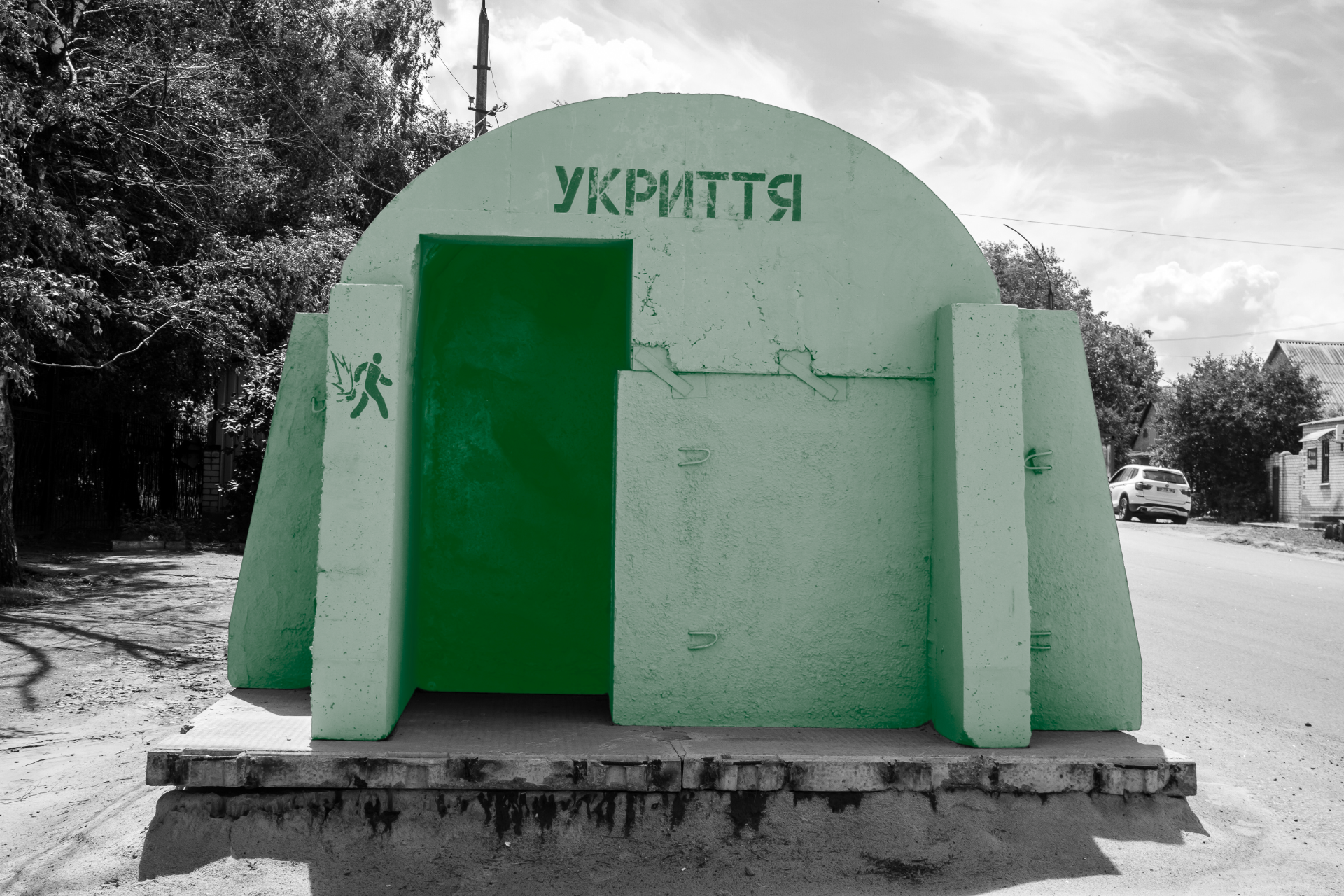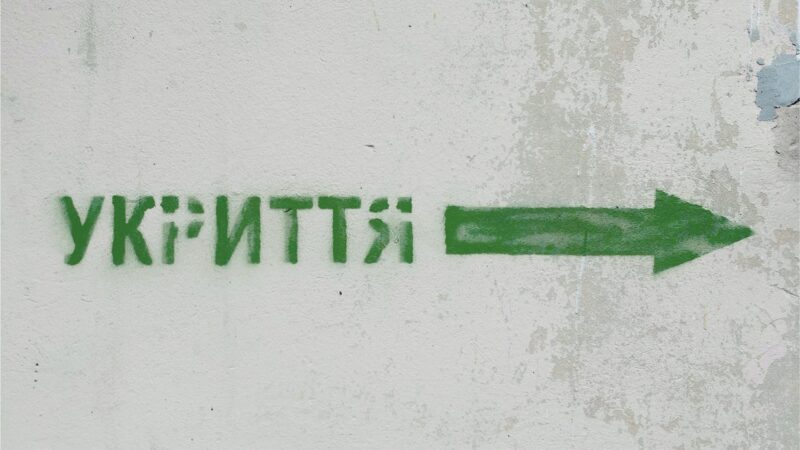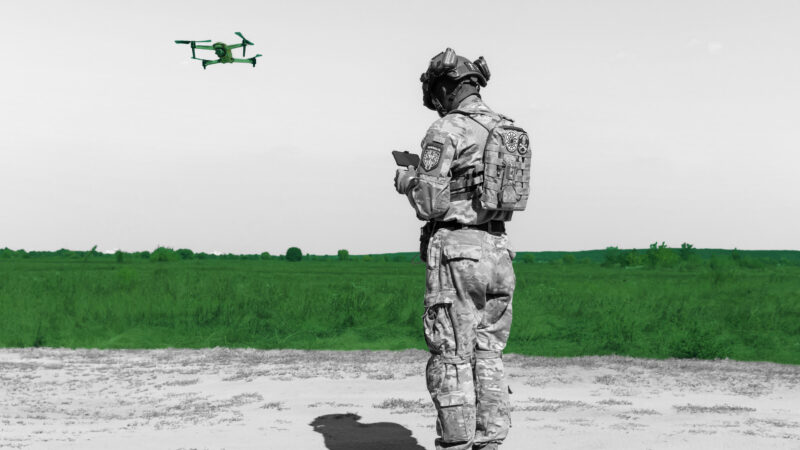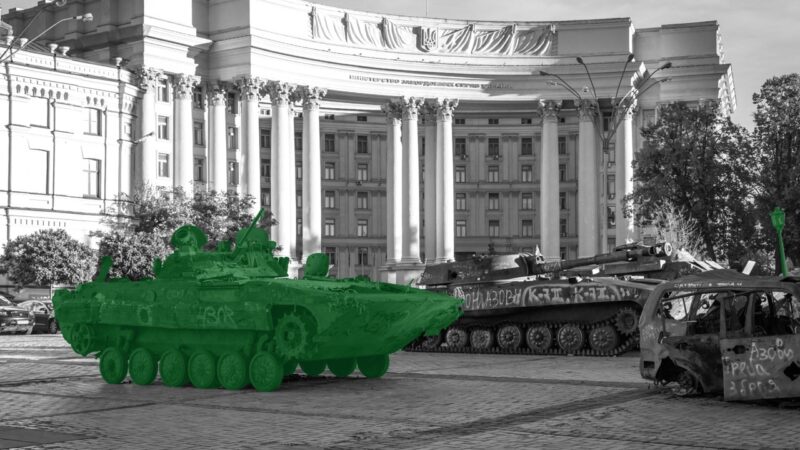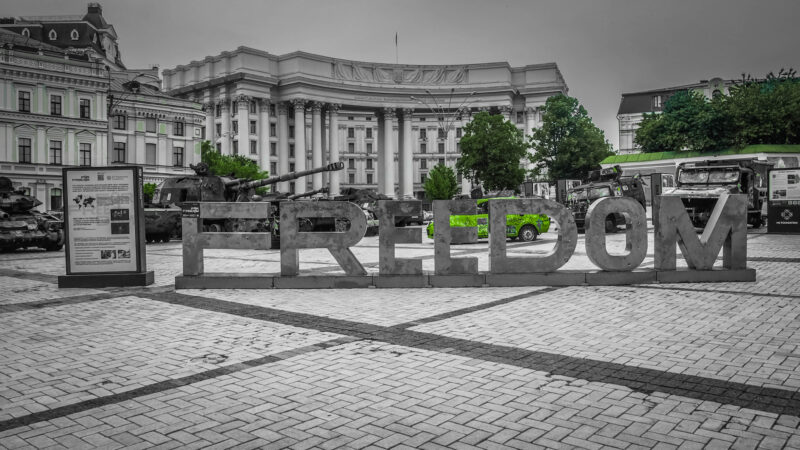Interview with Bohdan Ben and Orysia Hrudka | “Back to first principles: Ukrainian journalism in wartime”

Jonah Makowsky: Your book Dark Days, Determined People: Stories from Ukraine under Siege aims to highlight the experiences of everyday Ukrainians forced to overhaul their lives in the face of Russian aggression. Why do you think the media so often overlooks these narratives? Do you see a difference in how such stories are presented in the West compared to Ukraine?
Bohdan Ben: For Ukrainians, there is definitely a difference in how stories are presented. In the beginning of the war, western audiences often preferred something “exotic,” such as traditional grandmothers in shawls. In reality, you’ll really only find this in some remote villages or among the elderly. The other common trend at the beginning, as far as I could observe, was a focus on people and areas that directly suffered from the war. The foreign media tended to focus on these images because they seemed unusual or interesting to them and captured the attention. The problem is that this reinforces stereotypes about Ukrainians for foreign audiences.
Later, the focus of the media became much more diverse but still mostly related to the war—which is understandable, since the war is the central issue. However, in doing so, it often overlooks important topics that actually explain why the war is happening and why it cannot be solved through a simple deal. Understanding those deeper issues is essential if we want to grasp the nature of this war and how we can move forward.
Orysia Hrudka: What I’ve noticed is that the problem isn’t always the stories themselves, but which stories get selected. Sometimes I see narratives that are not outright victim-blaming but still suggest that Ukraine is somehow at fault. It seems hard for some in the West to believe that such a war could happen in a developed country, among people who are essentially the same as those in the West, living similar lives. And so, it is as if there has to be something “wrong” with Ukrainians to explain why this is happening to them. It is not victim-blaming directly, but comes very close to it.
I wrote an article asking Ukrainian people who had moved abroad due to the war about the stereotypes they faced. Almost all of them experienced someone explaining to them how to use a washing machine or a dishwasher. Ukrainians were often portrayed as if they came from a very underdeveloped country and were unfamiliar with modern technology. But I lived in Europe for many months, and life in Ukraine is not very different. What happened in Ukraine shocked many people because they simply couldn’t believe something like this could happen in the twenty-first century. Now we all understand that it can. We would like to see more stories that show this war is happening to people who are essentially the same as those in the West.
Another issue is that when a story isn’t dramatic enough or doesn’t involve a high number of casualties, it often goes unreported. That is the classic approach in news reporting. In our book, we tried to do it differently. We attempted to tell a story from multiple angles and in various dimensions. We also wanted to introduce the historical dimension and to situate the war and Ukraine’s current narratives within the context of people’s motivations. Those motivations are often shaped by the stories they heard from their grandparents or by the lessons they absorbed in history classes.
Makowsky: Russian propaganda works to strip Ukrainians of their humanity and distorts how Ukraine is perceived in the West. Considering the power of personal stories in shaping public perception, how can storytelling be used to counter Russian disinformation about Ukraine?
Hrudka: If you have relatives or ancestors in a country, it’s easier to take an interest. If you don’t have a connection to the country, it requires an effort to visit Ukraine or become acquainted with Ukrainians. However, once you meet people and learn about them, you naturally become more engaged.
When I was in the US in October and spoke with people, I noticed that if they had no personal connections to Ukraine, it was often difficult for them to be genuinely interested. At its core, it’s about empathy and the willingness to listen to other people’s stories. Often, that first personal connection is what makes the difference. But of course, we also wrote this book for those who don’t have such ties, which is why we included so much context throughout.
The genre in which the stories are written cannot be translated properly, but it’s called “literary reportage” [literaturnyi reportazh] in Ukraine. The idea is to tell the story as if it is fiction, but in reality it is non-fiction. It’s completely factual. You describe what people smell, see, and touch, so the reader feels as if they are there, experiencing it firsthand. Many people simply cannot be here. But by reading these stories, they can imagine themselves in these situations. We tried to capture and convey what Ukraine really feels like as much as we could.
When we see dramatic events in the news about Ukraine, it can seem like everything has been bombed. We also had the same impression when the full-scale invasion started. We were in Scotland at the time, but we returned to Ukraine two weeks into the war. We had read all this news about Chernihiv as if everything was destroyed and there was nothing left of the city. When we visited Chernihiv in May of the same year, reality was much different. Of course, many buildings were destroyed, but most of the city was still alive, with children playing and daily life continuing after the siege ended. That side of the story rarely makes it into the headlines.
Ben: Europeans are now somewhat more familiar with Ukraine than American audiences, partly due to physical proximity. Many Ukrainians have lived in Europe, and many Europeans have come to Ukraine. There was already a strong cultural exchange before the war, and it has continued during the war. With the US, those connections are harder to build, which makes it more difficult to create the same level of familiarity.
The point of our book was to share these stories as if we were telling them to a friend, explaining to them the context and background of what’s going on. When you have an in-depth conversation with someone, they’re more likely to look deeper into Ukraine. We also traveled extensively across Europe, often staying in one place for several days and talking with locals rather than just passing through. That gave us a better understanding of those countries, and it’s the same principle we applied in our writing. We can use language and journalism in this way to foster real understanding.
Makowsky: One thing I noticed while reading your book is that both of your writing styles strike a delicate balance. You give readers the necessary political context for each story’s timeframe, while also offering a deep, personal understanding of the human experiences behind those events. Could you comment on how you achieved that balance of being informative while still allowing these deeply human stories to resonate with readers?
Hrudka: From the beginning, our goal was to tell the stories of Ukrainians. The news tends to be dramatic, but our stories are also extraordinary in many ways. We focused on people whose lives and personalities are rarely explored in depth by the news, simply because the news format is so time-limited. Our first intention was always to write about people and expand upon their personal stories.
We initially wrote the book in English as we were already working with English-language media. Once you start writing with that audience in mind, you realize it’s essential to explain the political context. While that came second, it was also an inevitable and essential component.
Sometimes, we even went beyond what was strictly necessary, especially in the story “Blue and Yellow, Black and Red.” We visited a cemetery where soldiers were being buried, and we wanted to share its political and historical background, highlighting how many people from different countries and religions were buried there. In that sense, we gave ourselves the freedom to go deeper. That choice also reflected our backgrounds in political science and our interest in history. We wanted to offer readers that additional layer of context.
I found it interesting to read a review of our book where the reader noticed the political and historical context first. For us, the most important thing was always the stories of people. However, the fact that some readers notice the context before anything else shows how necessary it is to explain Ukraine’s background to foreign audiences.
Ben: It was important for us to research before writing the context. To write even a single paragraph, we studied a great deal of material and not only what we already knew. For example, in the story about the cemetery, we drew on both scientific and journalistic articles to provide a fuller picture.
This was very interesting for us because decades of Soviet oppression had kept so much of this information hidden in Ukraine. People knew there had been mass executions, but there was no evidence, no memorials, no public history about these events. Only recently has knowledge begun to emerge. For example, in the book, we mention that just before the war in 2021, large excavations began in Odesa at sites of mass executions from Soviet times, where thousands of people were killed. Sadly, the war interrupted this work. There are many similar examples.
Much of this information is still fresh, and some research continues despite the war. We felt it was important to summarize and preserve this knowledge and bring attention to it, not only for the world but also for Ukrainians themselves, especially since this knowledge had long been suppressed.
Hrudka: History is a crucial factor here in every sense. During Soviet times, information was silenced. People could not speak about the Holodomor for many years. Serious research on many aspects of our past only began after Ukraine gained independence. We are still just beginning to uncover, research, and understand so much of our history.
Some people are not very interested in this history because of the “post-soviet” legacy— although I don’t like this term. Many Ukrainians were educated under the Soviet system, which generally discouraged curiosity. Not only did it suppress the truth about history, but it discouraged any genuine interest in history altogether. Only when traumatic events began happening in our own modern history did more people start to look back and show interest in their grandparents’ stories.
History helps explain why today’s events are happening. It reveals patterns that have repeated across the generations. That’s why we also included the number of Soviet crimes directed by Moscow. In that sense, we can say they were Russian crimes. This historical dimension was important to us.
Makowsky: Young people often receive a great deal of media attention, yet they are also very vulnerable to having their trauma exploited. How do you see Western journalism navigating that tension? Do you think the personal stories and trauma of young people are sometimes exploited by Western media, especially compared to Ukrainian journalism?
Hrudka: It’s interesting because it sometimes works both ways. From the perspective of the media and even some organizations I’ve worked with, there are stories that are so personal and painful that sharing them can cross someone’s boundaries. You question whether you should publish them at all. At the same time, those stories are often the ones most likely to attract international attention.
Sometimes it’s Ukrainians themselves who decide to share something that might be considered unethical toward the person involved, simply to keep attention on Ukraine. After the war became a “new normal,” interest in Ukrainian stories started to fade. Everyone grew used to the fact that there was a war with Russia, and many reports began to sound the same. In trying to sustain attention, Ukrainians have sometimes resorted to this approach. In that sense, it isn’t only Western media that engages in potentially exploitative reporting.
In some cases, it also depends on the individual journalist. Not every Ukrainian journalist acts responsibly. For example, Russia attacked a bus in Kherson, and a man’s wife was killed. A journalist from a local outlet approached the husband immediately afterward to ask him questions, and the man hit the journalist. Many of the other journalists who witnessed the incident agreed with the husband’s reaction because the reporter put himself in an unethical position. Maybe he was inexperienced or came from an outlet with lower standards. Regardless, it was a clear example of unethical journalism.
If you work a lot with these topics and approach people as people rather than just interviewees, you act ethically from the very beginning. For example, you shouldn’t pressure them to talk about something like torture. In one of our stories from the Chernihiv region, we spoke with a man who had been tortured. He told us what had happened, but he didn’t want to go into detail, and we didn’t insist on it.
Many journalists who work with stories like this over time understand that the interviewee is first and foremost a person. Journalists themselves live under the same conditions, facing nightly missile and drone attacks, and the building they’re in potentially being hit.
I often think of a poem by Victoria Amelina, a writer who was killed in Kramatorsk during a Russian attack. She only began writing poetry after the full-scale invasion. In one poem, she compared missile and drone attacks to everyone being forced to stand against a wall, waiting to be shot. That is how it feels. As journalists, we live under the same risks as the people we interview. We know we are in the same position, and we behave accordingly.
I often hear from local producers and fixers who work with international media in Ukraine that, unfortunately, many foreign journalists treat these experiences simply as stories to capture, as if the people themselves don’t matter. We describe such an example in our book in which a man was crying because he had lost his son, and a French journalist kept pressing him for information. Of course, that is not ethical.
Ben: I can add only a few things to what Orysia said. It’s important to tell the truth and to show how events really happened. Most people understand this, and they wish to tell their stories. For many, it isn’t retraumatizing, or at least they choose to tell their stories when we speak with them.
However, there is a problem in which people in Ukraine and abroad become used to the violence, and these stories start to feel normal. As a result, the media often sensationalizes the way they tell them, making the stories more horrific simply to capture attention. I don’t have a solution to this problem, but it is something that we’ve observed.
Maybe the only answer is to see people as people and to tell their stories in greater depth and not be pulled in by the trend toward sensationalism. Of course, we always have to ask whether a person is willing to share their story. If they are not, we should never insist.
Makowsky: Could you tell us more about the relatively new phenomenon of volonterstvo ‘volunteering’ in Ukraine and how it has changed during the war?
Hrudka: Even in Ukraine, public attention to volunteering support for the armed forces has declined. People have gotten used to it and think, “Volonterstvo is everywhere. We’ve already heard this story and don’t need to hear it again.” Volunteering was a major topic in 2022, but now everyone is aware of it, and most people personally know volunteers.
For example, every Sunday in Lviv, women gather to sell cookies, sweets, and cakes. They also cook soup for the military. You see them regularly. Since this kind of activity is so common, it’s difficult for the media—in both Ukraine and abroad—to find a way to cover these stories engagingly. As a result, they’ve largely stopped telling them.
Many of the stories in our book can also be read as stories of volunteering, although not everyone in them calls themselves volontery ‘volunteers’. For example, in the story called “The Road to Life,” people took action simply because they felt they had to. They didn’t even think of themselves as volunteers. There are many stories of people just doing what was right.
It’s interesting how this word is perceived because we understand what it means in a particular way. However, in our book’s stories, many of the Ukrainians wouldn’t define themselves as such. In Ukraine, we consider volunteers to be the people who do it very regularly, and the rest are not considered volunteers.
Oleksandr Pankieiev: In Western media, we sometimes see stories that reflect the darker side of the war, not just stories about heroes. War brings out not only the best in society, it also exposes the worst. How do we balance the good and bad of what is happening?
Ben: At the beginning of the war, it was state policy to focus on heroism and the media, both public and private, eagerly followed this approach. It was necessary to lift people’s spirits and inspire them. It was very important from the military command’s perspective, and it was done properly. This focus lasted for one or two months.
Later, when everyone became accustomed to the war and understood the reality in more detail, those stories no longer resonated as they did before. The government made adjustments in response, and the media started to show a more nuanced picture. It happened but came a little late. Due to the prolonged emphasis on heroism only, many people developed exaggerated expectations of the Ukrainian army, as in the 2023 summer offensive. When those expectations didn’t materialize, some people felt discouraged. Things have normalized since then.
The point is that the truth is important. It may sometimes be necessary to keep silent temporarily, but in the end, the truth should be told. It will turn out badly if you silence the news. That is one of the lessons we have learnt from this war.
Pankieiev: Ukrainian journalists are on the front lines not just in a literal sense but also in terms of reshaping journalistic standards. They’re reporting on difficult topics like war, human rights, and genocide, while simultaneously being part of a society that is experiencing atrocities. We published an interview on the Forum with your colleague Yevhenia Podobna, about the West’s journalistic standard of neutrality, which states that if we give a voice to Ukraine, then we also need to give a voice to Russia. You provide context in your book, but in many other cases, context is sometimes absent, and readers can receive a really distorted picture of what’s really happening. Do you think journalistic standards or even the rule of law in international affairs need to be reexamined or reformed?
Hrudka: In some ways, it’s not that journalistic standards in Ukraine are changing, but rather they are returning to earlier principles. When I read so-called “balanced” stories in Western media, I can often see the journalist’s bias. It becomes visible in many ways—in their wording, or in how much space they give to one side over the other. Orwell believed it was a right thing for a journalist to take a side politically because in this way, he is not hiding anything from his audience. And he also believed that it was imperative to expose lies and tell the truth. If the side you support is doing something wrong, you have an obligation to report on it. It may be painful, but for the well-being and integrity of your side, it must be done.
Ethical standards in Ukraine are evolving every day. When a journalist crosses a line, it can spark a large public discussion. A recent example involved a well-known photographer, who published close-up images of people injured or killed in a missile strike. The photos were striking, even beautiful in a way—which is uncomfortable to say, but that is how photography works. Many journalists criticized the decision, arguing that it was not right to publish such images.
One of the people they photographed survived. It is possible that once she recovered, she may not have wanted to see herself portrayed in such a vulnerable state, with bruises and rubble all around her. In fact, an organization I was working with temporarily stopped using their photos. They were effectively boycotted as a result of that decision. Situations like this arise frequently, showing how ethical boundaries are actively debated in Ukraine today.
Benedict Anderson wrote about “imagined communities.” For him, journalism was a force that historically helped to create modern nation-states. The voices of journalism and newspapers were the voices of the community itself. The journalist was part of that community and not just a dry recorder of facts.
In some cases, a journalist does function more like a computer, reporting straight news, where the goal is simply to provide accurate information. However, in long-form work, there is always interpretation, and where interpretation is involved, it becomes very difficult to hide what you believe. However, I want to reemphasize that regardless of journalistic standards, the truth is the most important thing. If you choose a side and you lie because you want to make your side look better, this is unethical.
Ben: I’d like to add two points. First, about journalistic neutrality. This model was useful at a time when people had limited access to information, and the role of journalists was to give each part of society a voice so readers could weigh the arguments themselves.
Today, on social media, we face the opposite problem—too many voices. With so much noise, the truth often gets buried or distorted. Everyone can say most anything they want, because there is often no moderator. In this context, the journalist’s role is not just to report both sides but to fact-check and uncover the truth. It has become too easy for journalists to look at social media, take one statement, then another, and present it as a “balanced” piece. But does that really add value? I don’t think so. What matters most to me is the truth—the courage to criticize the government when it does something wrong, as well as the prudence to showcase successes and improvements when they’re achieved. This has always been the traditional role of journalism. During the Russo-Ukrainian war, that role has become just as important, if not more so.
For example, there was the case of a Ukrainian journalist who wrote extensively about the failures of the military command. He exposed cases where commanders abused soldiers and documented instances that led to casualties. At first, many people criticized him, saying, “Why are you writing this? It demoralizes society.” But over time, it became clear that this kind of criticism contributed to real military reforms. As a result, new processes were created, the chain of command was improved, unmanned aerial units were introduced, and so on.
This is why such work is so important. Talking about problems is what leads to solutions. If you stay silent, the problems only deepen and grow stronger. That, too, is a crucial standard for journalism in wartime.
Hrudka: I’d like to add one short comment to what Bohdan said. A few years ago, people often described the information space as a “post-truth world.” I’ve noticed that many people now prefer blogs or social media accounts as their primary sources of information. They seem to absorb information more easily through personal stories, or when it comes directly from a person they follow. The image of the “unbiased, detached journalist” is no longer as effective as it once was.
As Bohdan mentioned, there is no real gatekeeping on social media. Professional newspapers have editors, and before the Internet, not everything and not everyone was published. Now, without that filter, anyone can say anything. That’s why we as journalists also need to use personal voices, and we need to be present in that same space if we want to be heard. Take fact-checking as an example. It’s incredibly important, but it doesn’t work if we only publish it on our own website and expect people to find it. We need to go where people are.

